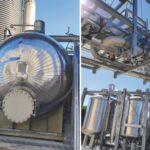BiesSse presenteds TPMM, a one of a kind machine that automatically mounts the double-sided tape and photopolymers at a rate of 50 sleeves/cycle.

At the latest Flexo Day (hosted by Atif, Bologna, 11 November 2015), BiesSse demonstrated a brand new polymer-mounting system based on innovative technology, drawing the interest and reflections of operators. Called TPMM (Tape Plate Mounting Machine), it was presented by Angela Conti as an industrial automation milestone, designed in the spirit of lean manufacturing to maximize efficiency in the flexographic preprinting process, with repeatable mounts, high precision and little waste.
The basic idea is (relatively) simple: to carry out all manual mounting operations automatically and on the same machine.
But in order to make that a reality, the BiesSse engineers had to overcome a series of troublesome and sensitive obstacles.
Functions and issues
In order to perform its duties, the TPMM must manage five main activities: sleeve measurement; removing the liner and cutting the tape; mounting the tape; mounting the plate; final check.
In concrete terms, this means first of all the possibility of picking photopolymers from a special magazine and correctly decoding them, taking into consideration that those already used can have curved edges. In this case, the first challenge consisted in the fact that the vision and transport systems must manage materials with widely varying thickness, size, color, hardness and brand, without damaging the photopolymer. The pressure must be homogeneous in order to prevent folding or skids, and the position of the tapes on the sleeve must be very precisely measured in order to guarantee positioning accuracy to the tenth of a millimeter.

Just one cycle
With TPMM, the BiesSse team has developed a system capable of mounting in just one cycle 50 sleeves, complete with double-sided tape and photopolymers. It’s main characteristic is its ability to automatically identity the initial position and size of the photopolymer with micrometric accuracy using precision cameras, and to process the destination coordinates on the machine’s Cartesian plane, with minimal error. This represents a valuable feature, since considering real operating conditions, it means photopolymers can be loaded randomly. In fact, the picking device always positions itself on the first available slot, and, even when the photopolymers are not inserted in the order of mounting, it automatically selects those most suited to the mounting specifications.
Neither is orientation of the photopolymer a problem. The vision system detects any malformations and automatically repositions units while verifying their suitability both in terms of the sleeve and of the customer’s order specifications.
two other essential automated systems introduced by the TPMM have to do with the size of the photopolymer, which is checked and any malformations of which are signaled, and sleeve insertion pressure, which is adjusted according to diameter.
Multitasking and traceability
In order to reduce the cycle time as much as possible, the TPMM’s designers have conceived a motion management system with an eye to multitasking. While the system is performing a given operation, the operator can perform other operations simultaneously on other areas of the machine.
The necessary grade of integration is reflected in the monitoring system, which processes the data received from the various customer databases and collects order sequencing information, work cycles, sleeve sequences and photopolymers used… Once the sleeve has been mounted, the machine automatically prints the labels with the main information pertaining to the operation just completed; any data is stored in an SQL database for complete process traceability. With a further very appreciable practical effect: according to the number of photopolymers to be mounted, the surface of the tape needed to carry out the operation is (automatically) calculated.














